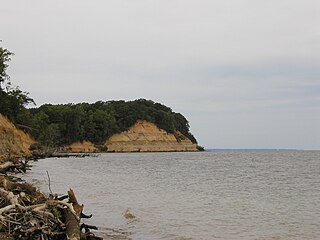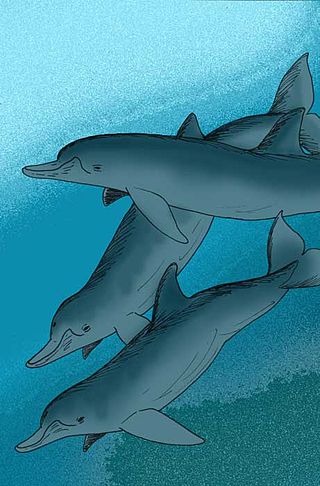
Calvert County is a county located in the U.S. state of Maryland. As of the 2020 census, the population was 92,783. Its county seat is Prince Frederick. The county's name is derived from the family name of the Barons of Baltimore, the proprietors of the English Colony of Maryland. Calvert County is included in the Washington–Arlington–Alexandria, DC–VA–MD–WV Metropolitan Statistical Area. It occupies the Calvert Peninsula, which is bordered on the east by Chesapeake Bay and on the west by the Patuxent River. The county has one of the highest median household incomes in the United States. It is one of the older counties in Maryland, after St. Mary's, Kent County and Anne Arundel counties. The county is part of the Southern Maryland region of the state.

Carcharodon is a genus of sharks within the family Lamnidae, colloquially called the "white sharks." The only extant member is the great white shark. The extant species was preceded by a number of fossil (extinct) species including C. hubbelli and C. hastalis. The first appearance of the genus may have been as early as the Early Miocene or Late Oligocene. Carcharocles megalodon is still argued by some paleontologists to be a close relative of Carcharodon carcharias - as well as being in the same genus. The megalodon's scientific name was originally "Carcharodon" megalodon, but more recently, the giant shark has been assigned by most scientists to either the genus Carcharocles or Otodus.

Calvert Cliffs State Park is a public recreation area in Lusby, Calvert County, Maryland, that protects a portion of the cliffs that extend for 24 miles along the eastern flank of the Calvert Peninsula on the west side of Chesapeake Bay from Chesapeake Beach southward to Drum Point. The state park is known for the abundance of mainly Middle Miocene sub-epoch fossils that can be found on the shoreline.

Rachycentron is the only known member genus of the family Rachycentridae. The genus contains a single living species, the cobia, and the Late Miocene fossil species Rachycentron stremphaencus from Maryland.
Scientists' Cliffs is an unincorporated community in Calvert County, Maryland, United States. Other names used for the community include Annes Aggravation, Flippos Folly, Pathologists Quagmire.

Pelagornis is an extinct genus of prehistoric pseudotooth birds, a group of extinct seabirds. Species span from the Oligocene to the Early Pleistocene. Members of Pelagorinis represent among the largest pseudotooth birds, with one species. P. sandersi, having the widest wingspan of any bird known.

Australodelphis mirus is an extinct Pliocene dolphin. A. mirus is known from fossils found in the Sørsdal Formation, Mule Peninsula, Vestfold Hills, East Antarctica. The genus has been described as an example of convergent evolution with beaked whales.

Parietobalaena is an extinct genus of baleen whale, belonging to the family Pelocetidae. Fossils are found in Miocene-aged marine strata in North America, Europe, Australia, and Japan, including the Temblor and Itahashi formations. Based on previous estimates of juvenile specimens, Tsai (2017) suggested a body size of 12-15 m for P. yamaokai, akin to that of the gray whale.

Astroscopus countermani is an extinct species of stargazer described from a cranium found in Tortonian deposits of the Calvert Cliffs of what is now Maryland. A. countermani is very similar to its living relatives.

Lopholatilus is a small genus of tilefishes native to the western Atlantic Ocean.

The Chesapeake Group is a geologic group in Maryland, Virginia, Delaware, and North Carolina. It preserves mainly marine fossils dating back to the Late Oligocene through the Pliocene epochs of the Neogene period. This group contains one of the best studied fossil record of Neogene oceans in the world. Professional Paleontologists and amateur fossil hunters alike collect from this group intensely. The Calvert Cliffs stretch the length of Calvert County, Maryland and provide the best continuous stretch of the Calvert, Choptank, and St. Marys Formations. Ward (1985) recommended including the Old Church Formation in this group.
The St. Marys Formation is a geologic formation in Maryland and Virginia, United States. It preserves fossils dating back to the Miocene Epoch of the Neogene period. It is the youngest Miocene formation present in the Calvert Cliffs and is part of the Chesapeake Group.
Araeodelphis is an extinct genus of river dolphin from the early Miocene of the East Coast of the United States.

Lophocetus is an extinct genus of dolphin belonging to the clade Delphinida that is known from late Miocene (Tortonian) marine deposits in California and Maryland. Although usually placed in Kentriodontidae, recent studies have found it only distantly related to Kentriodon.
Phocageneus is an extinct genus of river dolphin belonging to Squalodelphinidae. Specimens have been found in the middle Miocene Calvert Formation of Maryland and Virginia.

Alopias grandis is a species of giant thresher shark from the Miocene. Estimates calculated from teeth comparisons suggest the living animal was comparable in size to the extant great white shark. Remains generally consist of teeth, which have been found in the United States in the Calvert Formation of Virginia and Maryland, and in Beaufort County, South Carolina. They have also been found in the Miocene of Malta. It is unlikely it possessed the elongated tail lobe of modern thresher sharks. Some specimens in the Burdigalian show the beginnings of serrations, which are presumably transitional individuals between A. grandis and A.palatasi.

Astroscopus, the electric stargazers, is a genus of stargazers, a type of percomorph fish from the family Uranoscopidae, part of the order Trachiniformes. The species in this genus are anatomically distinct uranoscopids, being characterized by internal nares and being the only group of marine bony fish having organs which produce electricity which are derived from the extraocular muscles. They are found on the Atlantic and Pacific coasts of the Americas.

Alopias palatasi, commonly referred to as the serrated giant thresher, is an extinct species of giant thresher shark that lived approximately 20.44 to 13.7 million years ago during the Miocene epoch, and is known for its uniquely serrated teeth. It is only known from such isolated teeth, which are large and can measure up to an excess of 4 centimetres (2 in), equating to a size rivaling the great white shark, but are rare and found in deposits in the East Coast of the United States and Malta. Teeth of A. palatasi are strikingly similar to those of the giant thresher Alopias grandis, and the former has been considered as a variant of the latter in the past. Scientists hypothesized that A. palatasi may have had attained lengths comparable with the great white shark and a body outline similar to it.

The Calvert Formation is a geologic formation in Maryland, Virginia, and Delaware. It preserves fossils dating back to the early to middle Miocene epoch of the Neogene period. It is one of the three formations which make up the Calvert Cliffs, all of which are part of the Chesapeake Group.

Messapicetus is an extinct genus of beaked whale from the Late Miocene. It currently holds two species, M. longirostris from the Tortonian of Italy and M. gregarius from the Pisco Formation of Peru. However, a third unnamed species is represented in the St. Marys Formation of Maryland known from fragmentary material. M. gregarius is sexually dimorphic, males having tusks which are hypothesized to have been used in intraspecific combat for mates as in extant (living) beaked whales.















